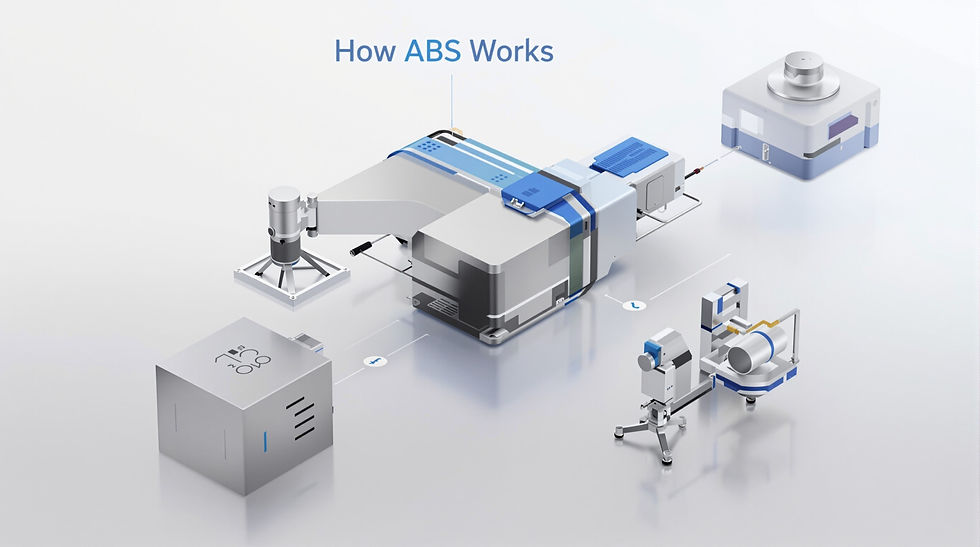Asset-Backed Securites & Tokenization
- BlackLeaf Wealth

- Mar 11
- 5 min read

The Future of Asset-Backed Securities (ABS) & Tokenized Real-World Assets
How Digital Securities are Reshaping Private Markets, Real Estate, and Alternative Investments
The financial world is undergoing a radical transformation with the advent of tokenized real-world assets (RWA) and blockchain-powered Asset-Backed Securities (ABS). Traditional financial instruments—such as real estate investments, commodities, private equity, and alternative assets—are being revolutionized by digital securities, enabling greater efficiency, liquidity, and accessibility.
Historically, asset-backed securities (ABS) have been a fundamental component of financial markets, allowing investors to trade structured financial products backed by tangible assets. However, they have been restricted to institutional investors, lacked transparency, and involved lengthy settlement times.Understanding Private Equity (PE)
Now, tokenization is reshaping this landscape. By leveraging blockchain technology, physical and financial assets can be digitized, fractionalized, and traded on global digital marketplaces with greater efficiency than ever before.
This blog explores the mechanics of ABS and tokenization, their advantages and risks, their future impact, and how they differ from traditional financial structures.

What are Asset-Backed Securities (ABS)?
Understanding Traditional ABS
Asset-Backed Securities (ABS) are financial instruments that pool together a set of income-generating assets and issue securities backed by these assets. These securities provide investors with a return based on the cash flows generated by the underlying assets.
Examples of traditional ABS include:
Mortgage-Backed Securities (MBS) – Backed by home loans
Auto Loan-Backed Securities – Backed by car loans
Student Loan ABS – Backed by education loans
Credit Card Receivables ABS – Backed by consumer credit payments
How ABS Works in Traditional Finance
Originator Issues Debt: A financial institution bundles together a set of loans or financial assets.
Pooling & Structuring: These loans are repackaged into tradable securities.
Investors Purchase the Securities: Institutional investors buy these ABS, receiving interest and principal payments over time.
Cash Flow Distribution: The return is generated from the payments made by borrowers of the underlying assets.
🔹 Limitations of Traditional ABS:
Highly centralized, controlled by major financial institutions.
Illiquid, requiring large institutional buyers.
Limited transparency, as ABS structures are often complex and opaque.

The Rise of Tokenized Real-World Assets (RWA) and Digital ABS
What is Tokenization?
Tokenization is the process of converting real-world assets into digital tokens on a blockchain. These tokens represent fractional ownership or claims on the underlying asset and can be traded, transferred, and stored securely.
Instead of relying on a centralized intermediary, smart contracts and blockchain technology enable peer-to-peer trading and automation of financial transactions.

Examples of Tokenized Real-World Assets:
Real Estate – Tokenized property ownership allows investors to purchase fractional shares of commercial or residential properties.
Commodities – Gold, oil, and agricultural commodities can be tokenized, making them tradable in smaller increments.
Debt & Private Credit – Institutional loans and debt securities can be digitized, improving transparency and liquidity.
Art & Collectibles – High-value artworks and luxury items can be split into tokenized shares.
How Tokenized ABS Works
Asset Pooling: A pool of real-world assets (real estate, auto loans, corporate debt) is selected for securitization.
Token Creation: Blockchain smart contracts tokenize the asset pool, representing fractional ownership.
Marketplace Listing: Investors buy and sell tokenized ABS on decentralized or regulated digital exchanges.
Automated Cash Flows: Smart contracts distribute interest payments and principal repayments directly to token holders.
The Advantages of Tokenized ABS and RWA
✅ 1. Increased Liquidity
Tokenization breaks large, illiquid assets into smaller, tradable units, making it possible for retail investors to access traditionally institutional markets. Unlike traditional ABS, where selling is cumbersome, tokenized assets can be instantly traded on digital exchanges.
✅ 2. Transparency & Security
Blockchain’s immutable ledger provides real-time tracking of asset ownership, cash flows, and transaction history. This removes counterparty risks and eliminates opacity that plagued traditional securitization markets.
✅ 3. Fractional Ownership & Accessibility
High-value assets—such as real estate, private equity, and fine art—can be fractionalized, allowing smaller investors to participate in markets previously reserved for institutions.

✅ 4. Faster Settlements & Lower Costs
Traditional ABS transactions take days to clear, involving intermediaries like custodians, brokers, and clearinghouses. With tokenization, settlements occur almost instantly, reducing administrative fees and paperwork.
✅ 5. Smart Contract Automation
Payments, interest distributions, and compliance checks are automated via smart contracts, reducing the need for manual processing and third-party oversight.
Challenges & Risks of Tokenized ABS
⚠️ 1. Regulatory Uncertainty
Governments and regulators are still developing frameworks for tokenized securities. Compliance remains a major hurdle, with varying global regulations on digital assets.
⚠️ 2. Market Adoption
Institutional investors and traditional financial firms are slow to adopt blockchain-based securities due to legacy infrastructure.
⚠️ 3. Security & Technology Risks
Although blockchain is secure, hacks, smart contract vulnerabilities, and fraud remain concerns in the digital asset space.
⚠️ 4. Valuation & Price Stability
Tokenized assets may face price volatility, especially in early-stage markets where liquidity is low.

Tokenization vs. Traditional ABS: The Key Differences
Feature | Traditional ABS | Tokenized ABS |
Liquidity | Limited, hard to sell | High, tradable 24/7 |
Transparency | Complex, opaque structures | Fully auditable on blockchain |
Settlement Time | Days to weeks | Near-instant |
Fractional Ownership | Not easily possible | Fully enabled |
Automation | Manual processes | Smart contract-driven |
The Future of Tokenized Real-World Assets & ABS
Institutional Adoption Is Accelerating:
Major banks, asset managers, and exchanges are integrating blockchain-powered ABS into their investment strategies.
Regulatory Frameworks Are Evolving:
Private Markets Are Being Disrupted:
Real estate, private credit, and infrastructure investments are becoming more accessible and liquid.
Forecast: A $16 Trillion Market by 2030
Industry analysts predict tokenized assets could reach a $16 trillion market capitalization by 2030, driven by institutional demand and mainstream adoption.

A New Era for Financial Markets
Tokenized ABS and real-world asset tokenization are ushering in a new era of financial democratization. By bridging the gap between traditional finance and blockchain technology, these innovations enhance liquidity, transparency, and accessibility across asset classes.
The future belongs to those who embrace digital transformation—as markets evolve, early adopters stand to benefit the most from this financial revolution.
💬 What are your thoughts on tokenized assets? Would you invest in a tokenized real estate or debt security? Let’s discuss, comment below.

BlackLeaf Wealth Financial Insights
📞 Schedule a Consultation – Contact Us: info@blackleafwealth.com
🔹 Stay Connected
Follow us for insights on global wealth management strategies.
Disclaimer
This article is for informational purposes only and does not constitute legal, tax, or financial advice. Readers should consult a qualified professional before making any decisions regarding trusts, foundations, or asset protection strategies. Regulatory frameworks may vary by jurisdiction, and improper structuring could lead to unforeseen liabilities.
Written by: BlackLeaf Wealth
March 11, 2025



Comments